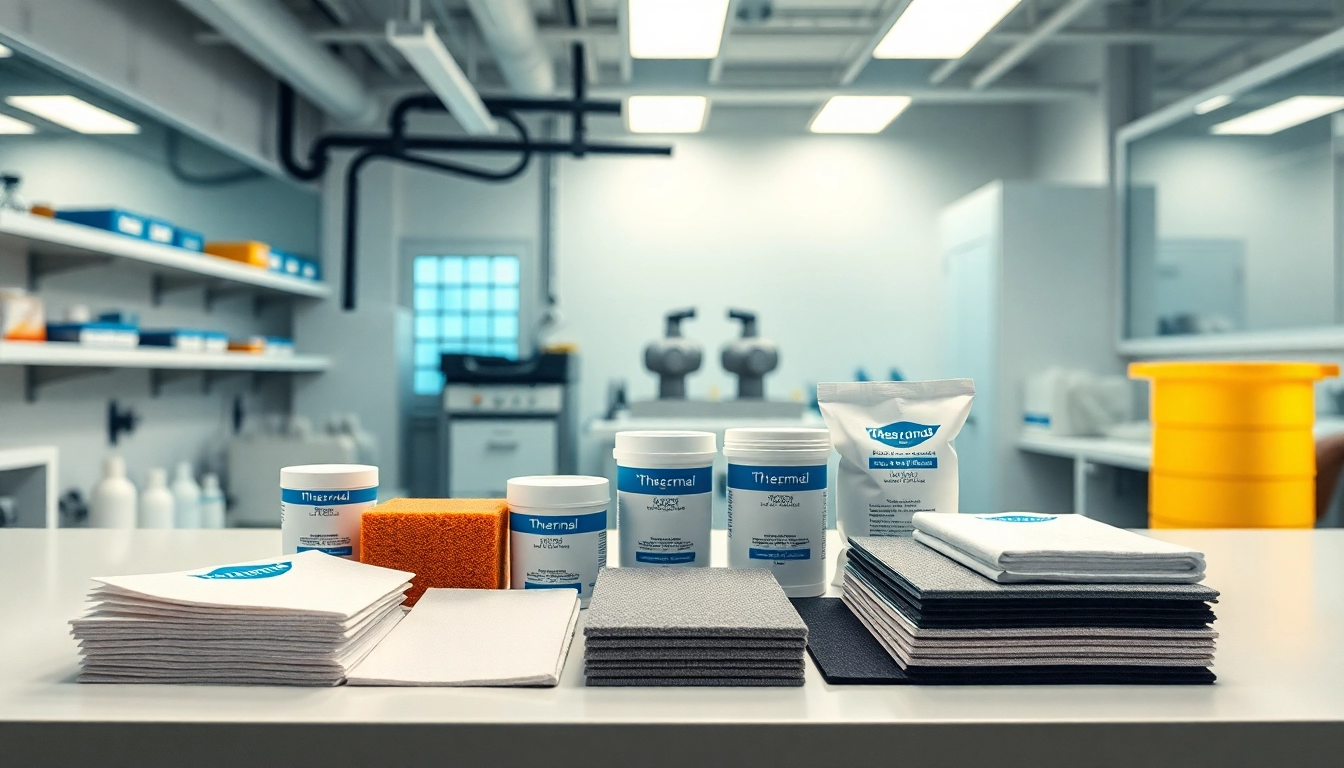Understanding Thermal Management Materials
What are Thermal Management Materials?
Thermal management materials refer to a variety of products designed to efficiently manage and dissipate heat in electronic applications. These materials are crucial for maintaining optimal performance and longevity of electronic components, as they help prevent overheating by enhancing heat transfer away from hot components to heat sinks or other areas where the heat can be safely dissipated. Common types include thermal interface materials (TIMs), gap fillers, thermal adhesives, and phase change materials. Each material type serves a specific purpose in the overall thermal management strategy of electronic devices.
The Importance of Thermal Management in Electronics
The importance of thermal management in electronics cannot be overstated. As devices become increasingly compact and powerful, the heat generated by electronic components tends to rise significantly. If not effectively managed, this heat can lead to thermal runaway, resulting in equipment failure, reduced reliability, and degradation of electronic components. Through the use of thermal management materials, manufacturers ensure that devices operate within safe temperature ranges, thus enhancing performance and extending service life.
Types of Thermal Management Materials
There are several key types of thermal management materials, each serving a unique function:
- Thermal Interface Materials (TIMs): These materials bridge the gap between heat-producing components and their heat sinks to improve thermal conductivity. They are often made from silicone, polymer, or metal-based substances.
- Gap Fillers: These are soft, conformable materials designed to fill air gaps between components and heat sinks, improving heat transfer efficiency.
- Thermal Adhesives: Used to bond components while simultaneously providing thermal management, these adhesives can enhance the mechanical integrity of a device.
- Phase Change Materials (PCMs): These materials absorb excess heat by changing from solid to liquid at a specific temperature, effectively controlling temperature peaks.
Key Applications in Electronics
Thermal Interface Materials in Electronic Devices
Thermal Interface Materials are vital in electronic devices, especially in applications involving high-performance computing, automotive electronics, and consumer electronics. TIMs improve the thermal interface between microprocessors or power components and their heat sinks, significantly reducing thermal resistance and enhancing heat dissipation. In applications such as laptops or smartphones where space is limited, effective TIM solutions become crucial for maintaining performance under load conditions.
Utilizing Heat Spreaders and Dissipators
Heat spreaders and heat dissipators are other critical components in thermal management systems. They serve the purpose of distributing heat evenly across a surface, further improving heat dispersion. Materials such as copper or aluminum are commonly employed for their excellent thermal conductivity. The manufacturing of these components to fit seamlessly into device designs is paramount, especially in devices exposed to extreme operating conditions.
Case Studies of Effective Thermal Management
Several case studies highlight the effectiveness of thermal management materials:
- High-Performance Computing: In data centers, advanced thermal interface materials were employed to manage the temperature of high-density server racks, significantly reducing CPU throttling incidents and improving energy efficiency.
- Automotive Electronics: Implementation of phase change materials in electric vehicle battery management systems has resulted in better thermal regulation, increasing battery life and efficiency.
- Consumer Electronics: A well-known smartphone manufacturer integrated gap fillers and thermal adhesives in their flagship device to eliminate hotspots during high-performance tasks such as gaming, thus enhancing the user experience.
Choosing the Right Thermal Management Material
Factors to Consider When Selecting Materials
When choosing thermal management materials, several factors need to be taken into account, including:
- Thermal Conductivity: The efficiency of heat transfer is paramount; materials with higher thermal conductivity can dissipate heat more effectively.
- Mechanical Properties: Consider the stiffness, compressibility, and adhesion characteristics of materials to ensure they will perform adequately under application-specific stresses.
- Durability and Stability: Select materials that withstand thermal cycles and do not degrade over time to ensure long-lasting performance.
- Ease of Application: Choose materials that are easy to apply and integrate smoothly into manufacturing processes.
Performance Metrics for Thermal Materials
Choosing the right thermal management material involves understanding several performance metrics:
- Thermal Resistance: Lower thermal resistance indicates better thermal performance.
- Thermal Conductivity: Measured in W/mK (watts per meter per kelvin), provides insight into a material’s ability to conduct heat.
- Contact Pressure: The pressure applied to the TIM during installation is critical for effective performance.
- Temperature Range: Materials must remain effective across the expected operating temperature range.
Industry Standards and Certifications
Adhering to industry standards is essential for thermal management materials. Many organizations have established benchmarks to ensure quality and safety:
- ISO 9001 for quality management systems
- UL certifications that ensure materials meet safety standards in electrical applications
- IPC standards that govern electronic assemblies and component specifications.
Best Practices for Implementation
Optimizing Thermal Material Application Techniques
Effective application techniques enhance the performance of thermal management materials. Consider these best practices:
- Clean Surfaces: Ensure that surfaces are free of contaminants to avoid compromising adhesion and performance.
- Correct Thickness: Apply the right thickness of TIM to avoid introducing air gaps, which could limit thermal transfer efficiency.
- Uniform Distribution: Use appropriate methods to achieve uniform distribution across the application surface.
- Control Application Conditions: Monitor temperature and humidity levels during application, as these can affect performance.
Avoiding Common Mistakes in Thermal Management
Common mistakes can lead to ineffective thermal management, including:
- Overapplication or Underapplication: Either can create inadequate thermal conductivity.
- Ignoring Material Compatibility: Using incompatible materials can lead to degradation over time.
- Neglecting Continuous Monitoring: Regular assessments and replacements of thermal materials help ensure ongoing performance.
Tools and Resources for Effective Management
Utilizing the right tools and resources supports the effective implementation of thermal management strategies. Key resources include:
- Thermal simulation software to model and predict heat behavior in devices.
- Material specifications and datasheets to guide selection and application.
- Standards organizations that provide guidelines and best practices for thermal management.
Future Trends in Thermal Management
Innovations in Thermal Management Technologies
The future of thermal management is poised for exciting advancements with the emergence of innovative technologies. These may include:
- Active Cooling Systems: The development of systems that dynamically adjust cooling based on real-time thermal data.
- Smart Materials: Use of materials that adapt to temperature changes autonomously to optimize thermal performance.
- Nanotechnology: The application of nanomaterials to develop new, highly efficient thermal interfaces and absorbers.
The Role of Sustainability in Material Development
Sustainability has become a primary concern in material development. Manufacturers are increasingly looking for eco-friendly materials that not only perform well but also have reduced environmental impacts. The use of recycled materials and biocompatible substances is on the rise, as industry leaders recognize their responsibility towards sustainable practices. Additionally, lifecycle assessments are becoming standard to ensure materials used in thermal management are sustainable from production through disposal.
Emerging Applications in New Industries
As technology advances, new applications for thermal management materials are emerging across various industries. For example:
- Renewable Energy: The rise of solar energy technology and electric vehicle batteries will drive demand for innovative thermal management solutions to maximize efficiency.
- Medical Devices: Advanced monitoring systems require tight thermal management to ensure proper functionality and patient safety.
- Aerospace: The increasing complexity of aircraft electronics necessitates high-performance thermal solutions to mitigate the effects of extreme conditions.












Leave a Reply